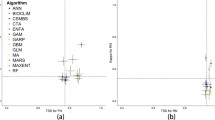Multivariate analysis provides an effective context for the examination of some significant aspects of biodiversity and conservation. The framework is a multidimensional space that integrates sample sites, taxa and environments. This approach enables terms such as representativeness, complementarity and irreplaceability to be integrated within an intuitive and practical framework for reserve design. Cluster analysis is proposed to determine ‘what is there’ by defining a set of complementary clusters. These clusters are sampled in a representative manner; from the core outward. The degree of irreplaceability of a site is defined as the multivariate distance of each potential reserve site to its nearest neighbour.
Similar content being viewed by others
References
Austin, M.P. (1985) Continuum concept, ordination methods, and niche theory. Annu. Rev. Ecol. Syst. 16, 29–61.
Austin, M.P., Cunningham, R.B. and Good, R.B. (1983) Altitudinal distribution of several Eucalypt species in relation to other environmental factors in southern New South Wales. Aust. J. Ecol. 8, 169–80.
Austin, M.P., Cunningham, R.B. and Flemming, P.M. (1984) New approaches to direct gradient analysis using environmental scalers and statistical curve fitting procedures. Vegetatio 55, 11–27.
Austin, M.P. and Margules, C.R. (1984) The concept of representativeness in conservation evaluation with particular relevance to Australia. CSIRO Division of Water and Land Resources Technical Memorandum 84/11. Canberra.
Austin, M.P. and Margules, C.R. (1986) Assessing representativeness. In Wildlife Conservation Evaluation (M.B., Usher, ed.) pp. 45–67. London, UK: Chapman & Hall.
Austin, M.P., Nicholls, A.O. and Margules, C.R. (1990) Measurement of the realized qualitative niche: environment niches of five Eucalyptus species. Ecol. Monogr. 60, 161–77.
Belbin, L. (1987a) PATN Reference Manual. Canberra: CSIRO Division of Wildlife & Ecology.
Belbin, L. (1987b) The use of non-hierarchical clustering of methods in the classification of large sets of data. Aust. Compl J. 19, 32–41.
Belbin, L. (1993) Environmental representativeness: regional partitioning and reserve selection. Biol. Conserv. 66, 223–30.
Benzecri, J.-P. (1973) L'Analyse des Données. Tome II; L'Analyse des Correspondence. Paris: 070 Dunod.
Busby, J. R. (1986) A biogeographic analysis of Nothofagus cunninhamii (Hook.) Oerst. in southeastern Australia. Aust. J. Ecol. 11, 1–7.
CSIRO Division of Wildlife and Ecology (1990) Forest issues: Processes and Tools for Inventory, Evaluation, Mediation and Allocation. Canberra: CSIRO Division of Wildlife and Ecology.
Currie, D.J. (1991) Energy and large-scale patterns of animal and plant species richness. Am. Nat. 137, 27–49.
Czekanowski, J. (1913) Zarys metod statystycznych w zastosowaniu do anthtopolgii. Warszawa: Naklad Towaraystwa Naukowego Warszawskiego.
Faith, D.P. (1992) conservation evaluation and phylogenetic diversity. Biol. Conserv. 61, 1–10.
Faith, D.P. and Walker, P.A. (1994) Diversity: Reference and Users Guide. Version 2.1. Canberra: CSIRO Division of Wildlife and Ecology.
Faith, D.P., Minchin, P.R. and Belbin, L. (1987) Compositional dissimilarity as a robust measure of ecological distance: a theoretical model and computer simulations. Vegetatio 69, 57–68.
Faith, D.P. and Norris, R.H. (1989) Correlation of environmental variables with patterns of distribution and abundance of common and rare freshwater macroinvertebrates. Biol. conserv. 50, 77–98.
Gelbach, F.R. (1975) Investigation, evaluation, and priority ranking of natural areas. Biol. Conserv. 8, 79–88.
Hill, M.O. (1973a) Diversity and evenness: a unifying notation and its consequences. Ecology 54 427–32.
Hill, M.O. (1973b) Reciprocal averaging: an eigenvector method of ordination. J. Ecol. 61, 237–49.
Kirkpatrick, J.B. (1983) An iterative method for establishing priorities for the selection of nature reserves: an example from Tasmania. Biol. Conserv. 25, 127–34.
Mackey, B.G., Nix, H.A., Hutchinson, M.F. and McMahon, J.P. (1988) Assessing representativeness of places for conservation reservation and heritage listing. Environ. Manage. 12, 501–14.
Margules, C.R. and Usher, M.B. (1981) Criteria in assessing wildlife conservation potential: a review. Biol. Conserv. 21, 79–109.
Margules, C.R., Nicholls, A.O. and Pressey, R.L. (1988) Selecting networks of reserves to maximize biological diversity. Bio. Conserv. 43, 63–76.
Margules, C.R., Cresswell, I.D. and Nicholls, A.O. (1994) A scientific basis for establishing networks of protected areas. In Systematics and Conservation Evaluation (P., Forey, C.J., Humphries and R.I., Vane-Wright, eds.) Systematics Association Special Volume 50, 127–350, Clarendon Press: Oxford.
Nix, H. (1982) Environmental determinants of biogeography and evolution in Terra Australis. In Evolution of the Flora and Fauna of Arid Australia (W.J.R., Baker and P.J.M., Greenslade, eds) pp. 47–66. South Australia: Peacock.
Pressey, R.L., Johnson, I.R. and Wilson, P.D. (1994) Shades of irreplaceability: towards a measure of the contribution of sites to a reservation goal. Biodiver. Conserv. 3, 242–62.
Pressey, R.L., Humphries, C.J., Margules, C.R., Vane-Wright, R.I. and Williams, P.H. (1993) Beyond opportunism: key principles for systematic reserve selection. TREE 8, 124–8.
Pressey, R.L. and Nicholls, A.O. (1989a) Efficiency in conservation evaluation: scoring versus iterative approaches. Biol. Conserv. 50, 199–218.
Pressey, R.L. and Nicholls, A.O. (1989b) Application of a numerical algorithm to the selection of reserves in semi-arid New South Wales. Biol. Conserv. 50, 263–78.
Tubbs, C.R. and Blackwood, J.W. (1971) Ecological evaluation of land for planning purposes. Biol. Conserv. 3, 169–72.
van der, Ploeg, S.W.F. and Vlijm, L. (1978) Ecological evaluation, nature conservation and the use of planning with particular reference to methods used in the Netherlands. Biol. Conserv. 14, 197–221.
Vane-Wright, R.I., Humphries, C.J. and Williams, P.H. (1991) What to protect —systematics and the agony of choice. Biol. Conserv. 55, 235–54.
Whittaker, R.H. (1978) Ordination of plant communities, 2nd ed. The Hague: Junk.
Williams, W.T. (1976) Pattern analysis in agricultural science. Melbourne: CSIRO and Elsevier.
Wright, J. (1970) Conservation as an emerging concept. Melbourne: Australian Conservation Foundation Occasional Publications No. 2.
Woinarski, J. and Norton, T. (1993) Issues Paper: Towards a National System of Forest Reserves. Canberra: Environment and Conservation Policy Division, Department of Arts, Sport, the Environment and Territories.
Wylie, J.L. and Currie, D.J. (1993) Species-energy theory and patterns of species richness: I. Patterns of bird, angiosperm, and mammal species richness on islands. Biol. Conserv. 63, 137–44.
Author information
Authors and Affiliations
Rights and permissions
About this article
Cite this article
Belbin, L. A multivariate approach to the selection of biological reserves. Biodivers Conserv 4, 951–963 (1995). https://doi.org/10.1007/BF00058206
Received:
Accepted:
Issue Date:
DOI: https://doi.org/10.1007/BF00058206




